
























by Will Nicholls
By the time you read this another Truth and Reconciliation Day will have passed. I guess Orange Shirt Day had too many shreds of residential school guilt attached to it to keep that name. So, a Canadian government bureaucrat came up with a solution – make it positive. Better that than commemorating the sadness of an Indigenous person remembering the special orange shirt taken away from her the day she was likewise stolen from her family, home and community by the residential school system.
The name sounds great when you know government-speak. After all, the truth is out there even if many people don’t know how to find it. There is a bank of testimony and information, but you need to search for it. Go to the National Centre for Truth and Reconciliation (website: nctr. ca), and you can discover a wealth of material. The NCTR was created as part of the Truth and Reconciliation Commission. This was one of the few things to come out of that commission. Almost all of the calls to action have gone unfulfilled to date.
While many schools across Canada do acknowledge Truth and Reconciliation Day (or week), many do not have resources or even know where the resources are to properly educate kids of different ages and class levels about why we have a Truth and Reconciliation Day.
One thing the school kids have is permission to wear an orange shirt (usually a t-shirt) on Truth and Reconciliation Day. Orange Shirt Day hasn’t really died because of the bureaucratization of the name.
What has happened is unfortunate but not surprising. Jackie Traverse, an Ojibway artist from Winnipeg, got a little surprise when she was online and saw
her original artwork being used on sites selling orange shirts for the September 30 event. She never gave anyone permission to use her artwork in this situation.
“They’re stealing from Indigenous artists and profiting off our trauma,” she said. Traverse has attempted to contact the people running the sites but has had no success in getting a response. In most cases they have taken her name off the artwork or put something over it.
She has said that they are using stolen artwork and “they don’t care.” An acquaintance sent “cease and desist” letters to the sites. While some complied, new sites popped up in no time at all. “You

just can’t really fight against it,” Traverse said.
In case you think Traverse is only concerned with profiting herself, she has donated to the Wa-Say Healing Centre in Winnipeg. The centre said that when you hear something like this, “it’s disappointing” to know they are being taken advantage of.
This story is just another example of how some truths and some reconciliations have a hell of a long way to go. As Traverse said, “They’re profiting off our trauma.” And that’s the one truth we have seen since the first residential school opened.
Jackie Traverse, an Ojibway artist from Winnipeg, got a little surprise when she was online and saw her original artwork being used on sites selling orange shirts for the September 30 event. She never gave anyone permission to use her artwork in this situation
The Nation is published every two weeks by Beesum Communications EDITORIAL BOARD L. Stewart, W. Nicholls, M. Siberok, Mr. N. Diamond, E. Webb EDITOR IN CHIEF Will Nicholls DIRECTOR OF FINANCES Linda Ludwick EDITORS Lyle Stewart, Martin Siberok MANAGING EDITOR Randy Mayer STORY COORDINATOR Patrick Quinn CONTRIBUTING WRITERS X. Kataquapit, S. Orr, P. Quinn, N. Fedosieieva, H. Nicholls DESIGN Matthew Dessner SALES AND ADVERTISING Danielle Valade, Donna Malthouse THANKS TO: Air Creebec CONTACT US: The Nation News, 918-4200 St. Laurent, Montreal, QC., H2W 2R2 EDITORIAL & ADS: Tel.: 514-272-3077, Fax: 514-278-9914 HEAD OFFICE: P.O. Box 151, Chisasibi, QC. J0M 1E0 www.nationnews.ca EDITORIAL: will@nationnews.ca news@nationnews.ca ADS: Danielle Valade: ads@nationnews.ca; Donna Malthouse: donna@beesum.com
SUBSCRIPTIONS: $60 plus taxes, US: $90, Abroad: $110, Payable to beesum communications, all rights reserved, publication mail #40015005, issn #1206-2642 The Nation is a member of: The James Bay Cree Communications Society, Circle Of Aboriginal Controlled Publishers, Magazines Canada Quebec Community Newspaper Assn. Canadian Newspapers Assn. Les Hebdos Sélect Du Québec. Funded [in part] by the Government of Canada. | www.nationnews.ca | facebook.com/NATIONnewsmagazine | Twitter: @creenation_news


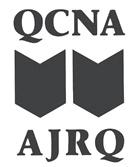

The Canadian Medical Association apologized to Indigenous peoples for historical harms caused by the healthcare system during a September 18 ceremony in Victoria, BC.
The CMA recognized the destructive impacts of Indian hospitals, medical experiments, child apprehension, forced sterilization, racism and abuse in the Canadian medical system.
“To Indigenous Peoples living in Canada, we apologize to you,” said CMA President Joss Reimer. “We are sorry. We are sorry we have lost your trust and for the harm you, your ancestors, your families and your communities have experienced. We acknowledge there are ripple effects on future generations.”
Dr. Reimer highlighted ongoing problems before about 200 guests, including local and national Indigenous leaders, physicians and Indigenous survivors.
“This is an opportunity to really reinforce the messages that Indigenous people are sharing about their experiences,” she told the Nation. “And then also to put a point in the history where we are committed to a different path.”
The organizers presented Unforgotten: Sonny MacDonald’s Story, a short film about a seven-year-old boy who was taken from his community to receive treatment for tuberculosis. He was incarcerated in the hospital for two-and-a-half years, enduring isolation, child abuse and torture.
Reimer said the Historical and Ethical Review Report, posted by the CMA on its website, describes systemic discrimination, social and economic inequities experienced by Indigenous people within healthcare services.
“Some of them were in our archives, some of them came from the conversations we had with community members, Elders and knowledge keepers,” she said.
In her opinion, harm due to systemic racism is still ongoing. “Systems were built to benefit some people over others,
Canadian
by Natalia Fedosieieva
but the CMA wants to be a part of the best future where we work with Indigenous peoples, where we provide the health care they need.”
The CMA is reopening its professional code of ethics, improving hiring practices, said Reimer.
“There is something we need to do in partnership with our Indigenous guiding circle, with local and national Indigenous leaders, with Elders and knowledge keepers,” Reimer said.
The ceremony included a speech from Dr. Alika Lafontaine, a physician of Cree and Anishinaabe ancestry, the first Indigenous president in the association’s 155-year history.
“Today the CMA is taking an important step in its reconciliation journey with Indigenous peoples,” Lafontaine said in his speech. “After years of internal work, the CMA is sharing and owning its history.”
Since the ceremony Lafontaine has received feedback that falls into two categories.
“Positive feedback was that this actually happened,” he told the Nation “Apology is just a step, it is not a solution to the problem, but is a necessary part in solving some types of problems, and the other part was asking what has actually been done?”
There are some projects where there is an opportunity for the CMA to address the harm caused to Indigenous people, and others where the CMA can support groups and organizations across the country looking for ethics and professionalism, Lafontaine explained.
“This apology is an important step in resolving issues and moving forward and being focused on the changing in attitudes towards Indigenous people,” he said.
Marlene Hale, human rights activist and a filmmaker from the Wet’suwet’en Nation, is leading the research for a fulllength documentary about systemic injus-
tice in Canada, where one of the five themes is crisis in the healthcare system.
One of her film’s stories highlights the death of Joyce Echaquan, the Atikamekw woman who died four years ago in the Joliette hospital after enduring racist remarks from medical staff.
In 2020 Joyce’s Principle was proposed “to guarantee to all Indigenous people the right of equitable access, without any discrimination, to all social and health services.” However, Hale said, “Access to healthcare is an ongoing crisis for Indigenous communities.”
In her opinion, this apology must be followed by action, including more funds to treatment centres, investing in underserved communities, and ensuring that marginalized populations receive equitable care.
“This is so close to September 30, when we mark the National Day for Truth and Reconciliation,” Hale said. “And this is where the government has to step in and really show Indigenous people that they are doing reconciliation.”
Society of Obstetricians and Gynaecologists of Canada (SOGC) President Lynn Murphy-Kaulbeck attended the apology ceremony and agrees “that you cannot do apology without action.”
In particular, Dr. Murphy-Kaulbeck identified the practice of forced sterilization. The SOGC reaffirmed in its statement that “coercive sterilization procedures are unethical and should never be performed.”
“We need to meet with our Indigenous partners” Murphy-Kaulbeck emphasized, “and say we must prevent this from ever happening again.”
Physicians need to learn cultural specifics from Indigenous groups, she added. “There needs to be a dialogue. We need to sit down and listen – not telling but listening – to give the type of care that Indigenous people deserve.”





Old Nemaska gathering hosts Quebec premier’s first visit to Eeyou Istchee by
Patrick Quinn, Local Journalism Initiative Reporter
While his visit to Eeyou Istchee was primarily for a renaming ceremony of the Eastmain hydroelectric complex, it was Premier François Legault’s memorable experience in Nemaska that may help build a better relationship between the Cree Nation and Quebec government.
On September 15, the Eastmain dam and generating station were renamed the Bernard Landry hydroelectric development. The adjacent basin was renamed the Paix des Braves reservoir in commemoration of the 2002 agreement between the Cree Nation and the PQ government led by Landry.
Former Grand Chief Ted Moses spoke about developing a close relationship with Landry through visits to each other’s homes and reminisced about travelling around his family’s trapline along the river that was dammed. Robert Kanatewat added further context regarding negotiations with the province for the James Bay and Northern Quebec Agreement.
“I paid tribute to our ancestors to honour the life and spirit that flowed through the river before the dams,” said Deputy Grand Chief Norman A. Wapachee. “To reflect on how much the Cree went through. I mentioned the wampum belt with two vessels using the same river, the balance between progress and preservation.”
Legault, who served in Landry’s cabinet at the time, said he was inspired by the strong partnership that his late predecessor developed with the Cree Nation. With HydroQuébec seeking to double its capacity in the coming years, Wapachee said there remain sensitive issues to discuss before collaborating on proposed wind energy projects.
Since the renaming ceremony coincided with Nemaska’s 47th anniversary celebrations, Chief Clarence Jolly arranged with Indigenous Affairs Minister Ian Lafrenière for the dignitaries to pay a visit to the community’s former village where the Rupert River widens into Lake Nemiscau. Coming to a remote Indigenous community with no idea of what to expect, Legault and his wife Isabelle Brais were visibly taken aback by the beautiful village and warm welcome.
Greeted by community members arriving by canoe to re-enact the new village’s founding, Nemaska director general George Wapachee said it was “like they were visiting Shangri-La in the middle of Quebec.” After asking about Nemaska’s history on the ride over, it was apparently only in the shaptuan when Wapachee told the story of their displacement that Legault realized that it was because of hydro development.
“I could see Legault trying to put these puzzle pieces together,” said Norman Wapachee. “Isabelle was a really good listener and helped him understand. What touched me was he said after 47 years, if somebody treated me like that,

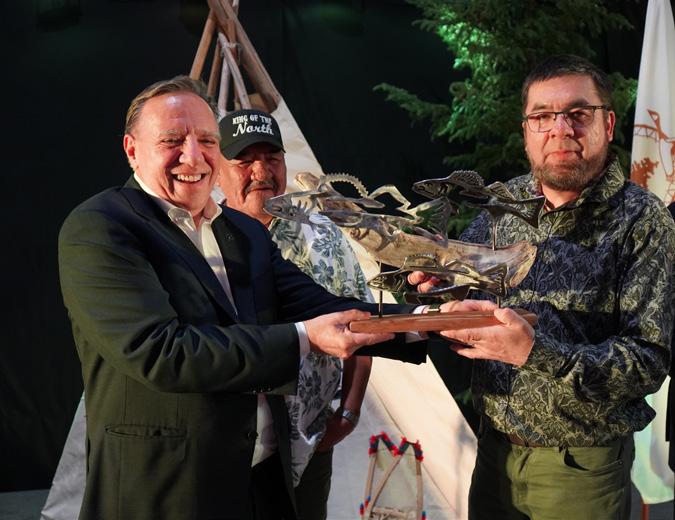
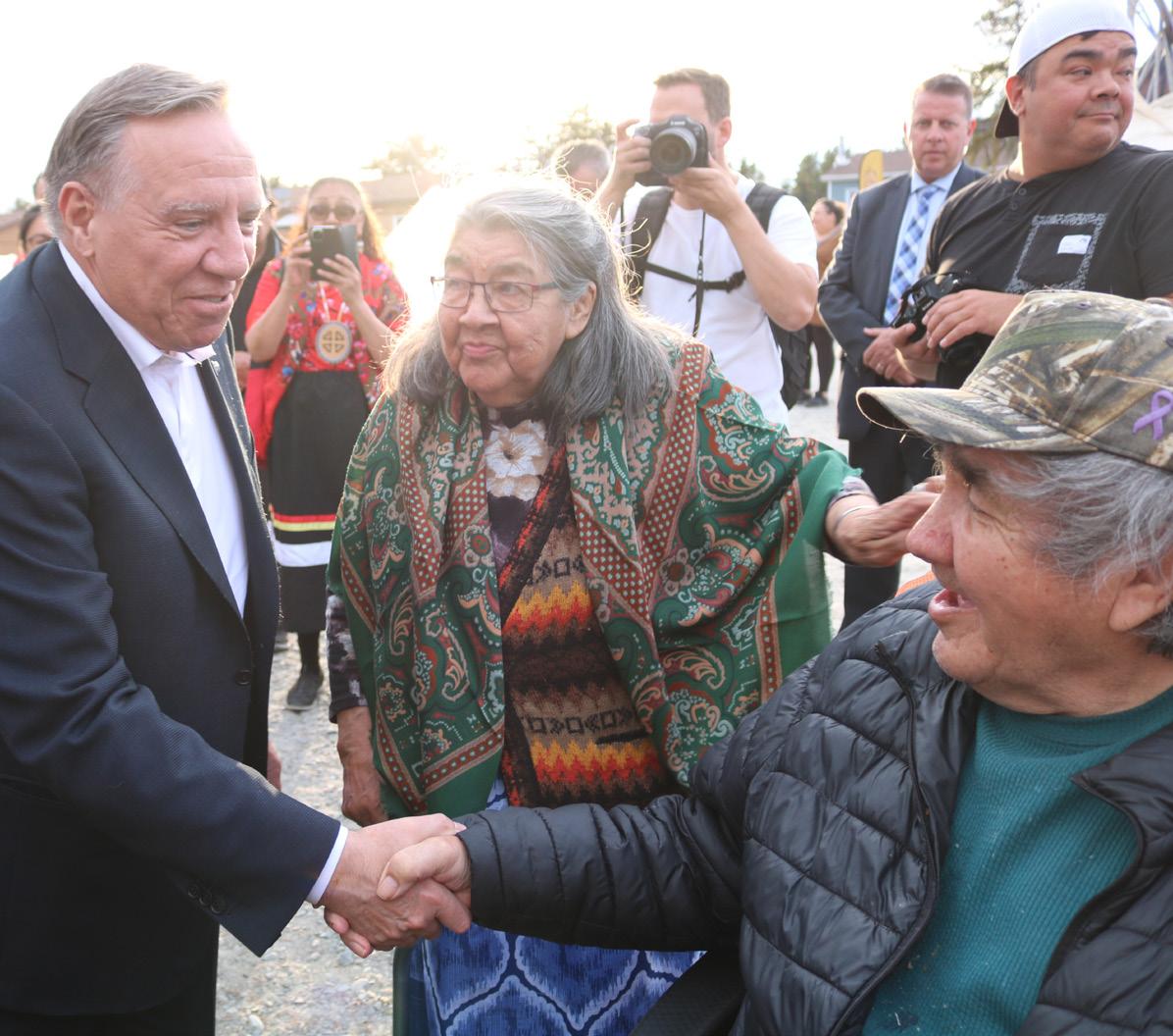
I would still be angry today. That room was full, and you could see all the smiles and excitement.”
Entering the banquet hall to a surprising standing ovation, Legault impressed with his “down-to-earth” nature and easy humour. As he munched on smoked sturgeon, he could be found mingling among community members, asking questions, sharing jokes and posing for selfies. A mechanical bull added to the festivities this summer brought more laughter.
“We were in a celebratory mood so let politics aside,” explained George Wapachee. “He’s very approachable. We’ve got some allies on our side now. At the end of his speech, he quoted the Terminator movie: ‘I’ll be back’.”
Riding together from the Route du Nord into Nemaska, Wapachee hinted to the premier that the first six kilometres of dusty gravel road is under provincial jurisdiction while the paved part after Champion Lake is federal. He hopes to build further understanding through giving Legault the book he co-authored with Susan Marshall: Going Home, The Untold Story of Nemaska Eenouch.
The 600-page historical account, researched and compiled over 15 years, was published by the community in 2022. The trauma begins when Nemaska people were scattered to the outskirts of Waskaganish and Mistissini between 1970 and 1977 in deplorable conditions, severing social ties and fuelling tensions between communities.
“Something that struck me, [Legault] asked, ‘Did Hydro-Québec tell you what they were doing?’” Wapachee recounted. “No, they never said anything. Workers doing feasibility studies told us, ‘You’ll be underwater, swimming around like the beavers.’”
In those days, Nemaska was under federal jurisdiction with the Quebec government out of the picture until they started looking for rivers to dam. Indian Affairs indirectly used the Indians of Quebec Association to tell Nemaska to move. Fearing the fate of Ouje-Bougoumou’s countless displacements, they asked themselves whether it would be the Grand Council or Indian Affairs to relocate them.
“But there is a third option – let’s go home ourselves,” recalled Wapachee. “It’s nothing new to what Crees did every year in those days. We all camped together in tents, had a big meeting and came up with a community plan.”
While the JBNQA enabled them to create their own community, Indian Affairs preferred a less costly option closer to existing roadways and refused to pay for a new road. Elders selected the site between Champion Lake and a stream, which later protected them from forest fires while IA’s proposed sites burned.
Although the Nemaska people were happy to have a home for the community, even if it was temporarily in tents, the insufficient funding and unrealistic deadlines for community-building caused many problems. Lacking clean water and
sewage systems, four children died from a gastroenteritis outbreak in the early 1980s.
“It happened because of the conditions imposed, that if you don’t move, you’re going to lose your right to move,” lamented Wapachee. “Somebody has to account for what happened to the people. It’s not settled. [Legault] seems to realize the wrong done to our people a long time ago.”
While Hydro-Québec kept Nemaska from returning to their original home, it was of course never flooded and remains a popular summer destination. There are even initiatives to build log cabins and improve its sanitation system. Wapachee suggested transferring some of the community’s Category 1b lands to Old Nemaska to deepen this connection.
When Legault asked people if they’d like to eventually return permanently, many said yes. As a traditional gathering place predating European contact, its landscape possesses the natural qualities that Cree have always valued in setting up camps. Wapachee told the premier the origin story that Billy Diamond loved to recite.
“One of our Elders landed on shore and there were pine trees all over,” narrated Wapachee. “The Elder took a piece of pointed stick, jabbed it into the ground, wiggled it around and the soil was good. The premier laughed when I told him about the Elder’s stick in the sand – that was his feasibility study.”
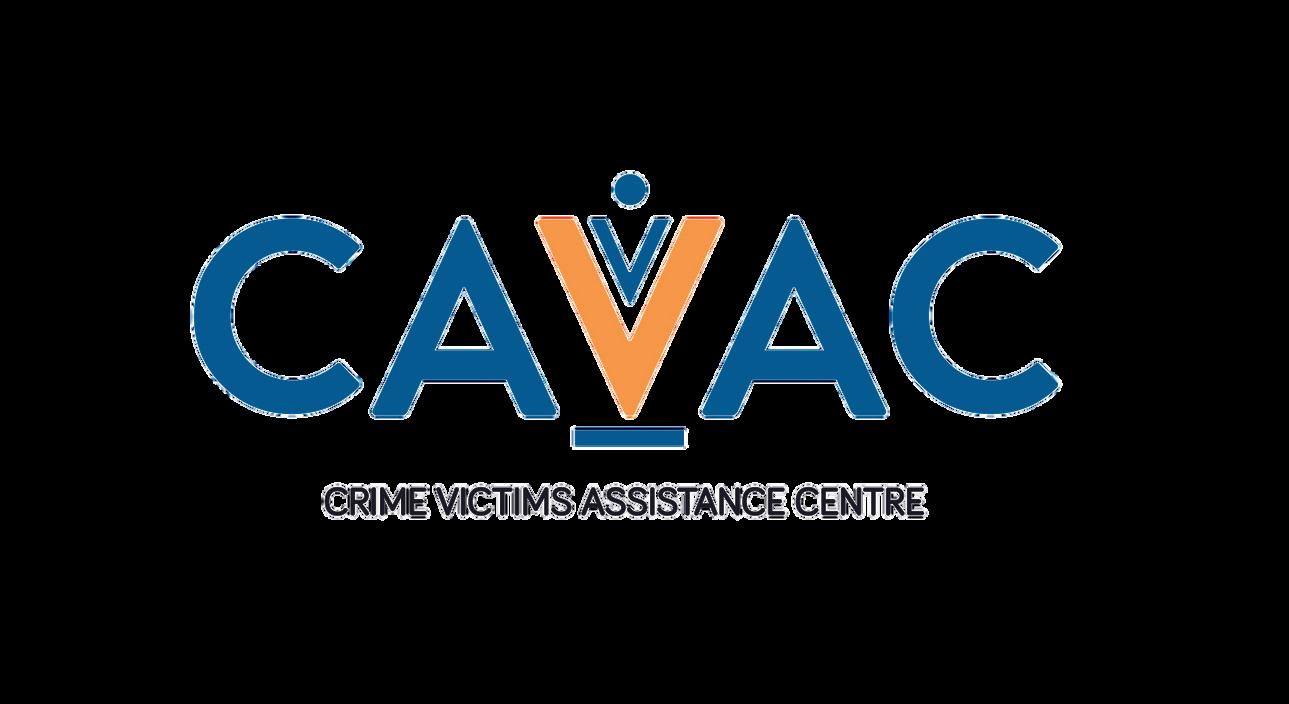


Elders gather in Nemaska
The 12th annual gathering of the Nishiiyuu Council of Elders was held in Nemaska September 17-21 with a focus on preserving and revitalizing Eeyou Iymuwin and Ituwin. Everyone was welcome for several hands-on culture and language workshops, including beading, carving, sewing and traditional medicine.
With over 100 Elders and 22 youth delegates, Elders had the opportunity to share knowledge and stories, making connections between communities. During the lighting of the sacred fire, Elder Samuel Mettaweskum explained that it provided safety and security for loved ones, even through hard times.
The annual gatherings began from a desire to demonstrate cultural values and teachings for younger generations so they may be proud of their heritage, restoring harmony and reconciliation within Eeyou Istchee. The event included community feasts, dances and presentations from various Cree entities.
Several organizations hosted information booths while the Cree Health Board offered reiki, massage, reflexology, cedar baths, sweat lodges and daily haircuts. There was a tribute to the late Robbie Matthew and Peter Wapachee shared the history of Nemaska’s community and cave paintings.
Jade Mukash, who received the Traditional Knowledge Award at the inaugural Miss Indigenous
Canada pageant, said she was “honoured to sing a traditional song every morning with the shiishiikuun for our Elders. It was beautiful to see this exchange of cultural knowledge – unforgettable.”
“Embracing the heartbeat of our vibrant culture, where the wisdom of our Elders weaves the fabric of language and tradition, each moment spent in their laughter and love is a priceless treasure, reminding us that the true legacy of our heritage is found in the stories shared and the bonds forged,” stated the Council. “Together, we honour the past while inspiring the future.”
As Mistissini’s Israel Mianscum attended his first Montreal Canadiens training camp, several Cree organizations posted messages of encouragement. Following medical evaluations and physical tests on September 18, the first pre-season game was September 23 at the Bell Centre.
“Beyond his athletic achievements, we recognize Israel’s promotion of a healthy lifestyle and the positive role
model he has become for our Nation,” stated the Cree Health Board. “We are proud of his hard work and dedication, and we wish him continued success in this exciting opportunity.”
The 21-year-old signed a two-season contract in June with the Laval Rocket of the Canadiens organization. Training hard all summer, Mianscum believes his versatility will enable him to adapt to any situation.
“Playing in Montreal is special, especially for a guy from Quebec,” said Mianscum this summer. “I’m very happy to have the chance to live this experience. In Laval, the fans there are crazy too. I couldn’t be more excited.”
Starting this fall, Montreal’s Concordia University is offering an innovative tuition-free initiative for all Indigenous students from Quebec applying for full- or part-time studies in most undergraduate and graduate programs. It won’t apply to executive MBA or continuing education programs.
“Concordia follows in the footsteps of many other
Canadian universities,” said Manon Tremblay, senior director of Indigenous Directions. “The difference with us is that we’ve extended this initiative to the entire province.”
Noting that many communities have limited funds and aren’t able to send their students for post-secondary education, Tremblay said the move promotes accessibility and equal opportunity.
Cree School Board chairperson Sarah Pash met with university officials in 2023 about supporting Eeyou students in reaching their goals. Last year, the CSB launched a new higher learning department to promote increasing post-secondary options within Eeyou Istchee and support its offices in Montreal and Gatineau.
While Quebec’s newest language laws have been criticized as barriers for Indigenous students, Concordia offers the Kaié:ri Nikawerà:ke Indigenous Bridging Program to help with securing prerequisites. There are also plans to renovate their Otsenhákta Student Centre, which connects students with peers and academic support.



by Patrick Quinn, Local Journalism Initiative Reporter
Months after the release of Red Fever, award-winning Cree filmmaker Neil Diamond is back with his latest documentary, So Surreal: Behind the Masks. Co-directed by Joanne Robertson, the film explores the fascinating connection between Indigenous ceremonial masks and the Surrealist art movement of the 1930s and 1940s.
“The Surrealists were interested in dreams in the act of creation,” Diamond told the Nation. “They would try to recreate dreams they had, considering them important, which is the same in Cree culture. I remember my father talking about certain dreams that were messages from who knows where – your mind, the universe?”
In the early stages of filming Red Fever’s dive into pop culture’s stereotypical Indigenous imagery, Diamond heard about a century-old mask selling at a high-end art fair and realized the story deserved its own film. His journey first takes him from New York City to the mask’s origin in Yup’ik territory, Alaska.
Inspired by images shining through the spirit world, shamans wore these masks crafted from wood and feathers during ceremonial dances as portals for transcendence and prayers for abundance. After fulfilling their purpose when the ceremony was finished, they were thrown into the fire to release their spirits.
As masks were integral for several Northwest Coast peoples, Diamond next visits the Kwakwa̱ka̱ wakw in Alert Bay, BC, whose traditional masks depicted animals they believed were their ancestors’ original forms. Between potlatch ceremonies, each family’s unique masks would be hidden away in a “box of treasures”.
“It was an archive, this is how our family or clan came to be,” explained Diamond. “They either came from raven, orca or grizzly bear. It was very theatrical. I remember going to the Museum of Anthropology at UBC in Vancouver where a person stood behind this carved pole and narrated the story told during the potlatch.”
While Yup’ik masks were purchased or found on the tundra by collectors, Kwakwa̱ka̱ wakw masks were confiscated or sold by the Canadian government after potlatch ceremonies were banned and several leaders were imprisoned in 1921. After the potlatch ban was finally deleted from the Indian Act, the feds only returned the masks when a gallery was built to house them.
“Many don’t know how vile the Indian Act was and is,” Diamond said. “They’ll be

shocked to learn people were put in jail for having ceremonies. There was no negative effect of having a potlatch. Somebody gave all their belongings away and started over again – it must have shocked the western mind.”
The documentary follows the gallery’s persistent efforts to repatriate their stolen history from international museums and the homes of rich collectors. George Heye’s massive collection, mostly acquired between 1905 and 1925, ended up in the National
Museum of the American Indian and German art dealer Julius Carlebach’s New York antique shop.
European surrealist artists fleeing fascist oppression during the Second World War were thrilled to discover these Indigenous creations in New York City, pooling their money to buy whatever they could. Studying these ceremonial objects obsessively and immersed in their imagination of the Pacific Northwest, they became funda-
mental inspiration for their subsequent artwork.
André Breton, the author of the Surrealist Manifesto in 1924, who introduced intuitive techniques to unlock the unconscious mind, declared the masks were more surreal than the Surrealists. Upon fulfilling one of his greatest desires by meeting Indigenous peoples, Breton said, “They touched me with their dignity and untouchable genius.”


When Breton’s collection was auctioned off by daughter Aube ElléouëtBreton in 2003, she realized there was a Kwakwa̱ka̱ wakw piece and immediately contacted the U’mista Cultural Centre in Alert Bay. Invited to return it in person, she participated in a moving ceremony and later donated money for its preservation – “a poster child for repatriation,” according to the Centre’s director, Sarah Holland.
“Repatriation is a complex beast,” Diamond asserts in the film, which
focuses on the Centre’s efforts to track down the elusive Raven Transformation Mask. This mind-blowing mask-within-a-mask would have a spellbinding effect during ceremonial performances, with the raven’s head opening to reveal a carved face at the dance’s dramatic climax.
Collaborating with art dealer Donald Ellis and a private investigator, they plan a letter to the mask’s present owner, the widow of French art connoisseur Georges Duthuit, carefully
avoiding the “R-word”. Options provided include donation, sale to a donor or a loan. Holland says they often find these pieces “when they’re ready to come home.”
So Surreal weaves together Indigenous history with insights from contemporary artisans and art experts. Yup’ik storyteller and dancer Chuna McIntyre is a charming character, accompanying Diamond in Paris to reconnect with his community’s masks
that have moved from Surrealist collections to institutions like the Louvre.
“For a long time, our works were treated as mere artifacts of the past, gathering dust in museum basements,” Diamond muses in a voice-over. Today they can be found adjacent to some of the world’s most revered masters and regularly sell for millions of dollars. However, Diamond hasn’t found an Indigenous language with a word for “art”.
“My dad used to make his own paddles, canoes, axe handles and even spoons for scooping out fish,” said Diamond. “He designed them to look beautiful. They weren’t just utilitarian, they looked pleasing to the eye.”
While there are increasing examples of successful repatriation, there are no Canadian laws enforcing this practice except for an Alberta law relating to First Nations sacred objects updated in 2016. During his research, Diamond found that Harvard University has numerous Indigenous skeletons in a basement whose origins have likely long been lost.
Revealing in the film that his grandfather and great-grandfather were shamans, Diamond reflected on the pervasive influence of colonialism that outlawed Indigenous ceremonies like the potlatch. In Eeyou Istchee, long-banned traditions like shaking tents are slowly being revived but still face resistance.
“A friend of mine who does counselling and is a traditionalist, recently wanted to have a sweat lodge ceremony outside Waskaganish and this group of people told him he better not,” shared Diamond. “That colonized mentality is still strong, that all these ceremonies we had were evil. Imagine if the Surrealists had discovered shaking tents?”










The Nation’s junior correspondent with his thoughts on the spooky season by
Hunter Nicholls








Halloween is an enjoyable event. It’s always fun being able to dress up as a character you admire or look at the spooky decorations and vibe some people create.
I love Halloween because people always put in an effort to make sure it’s enjoyable. Like the people who buy lots of decorations and hand out candy, the parents who buy their kids fancy costumes or the spooky TV show specials. It’s always fun to participate in Halloween no matter what you are doing.
It’s great that there are new Halloween movies being released when the season comes around like Beetlejuice Beetlejuice. It’s always a treat to go to the theatre on or around Halloween. Rewatching movies from previous years is great. Think of Halloween, The Nightmare Before Christmas, A Nightmare on Elm Street or Friday the 13th.
I recommend checking out Spirit Halloween, if you want to get some quality decorations. They have a lot of great eye-catching decor and animatronics. Their animatronics have activation pads that if you step on them, they react. The reactions consist of them popping out and trying to scare you. They move around and some even talk to you. These props are great fun.


But those are the outdoor decorations, Spirit Halloween also has indoor ones that consist of plushies, posters and blankets. Plus, they have sales occasionally that will help you save money. Spirit Halloween has the “Spirit of Children” campaign, which funds and supplies hospitals with Halloween stuff and volunteers throughout the entire year.
Spirit Halloween has a lot of officially licensed materials. The brands they have include Inside Out, Beetlejuice, Descendants: The Rise of Red, Haunted Mansion, Corpse Bride, Terrifier, Barbie, Teenage Mutant Ninja Turtles, Ghostface, Harry Potter, The Nightmare Before Christmas and Bluey.
Costumes are a huge part of Halloween. You can get lots of them at Spirit Halloween or Amazon. You can always find this year’s new shows and games. If you are looking for a costume, I’d recommend you go as a superhero like Deadpool, Wolverine, Spiderman, Batman or Superman. For a scary costume, you can be Beetlejuice, Jason Voorhees, Michael Myers, Freddy Krueger or Jigsaw. And for children, they can be Mario, Goku or SpongeBob.
Halloween is such an enjoyable experience, and I hope everyone reading this will enjoy it as much as I do!
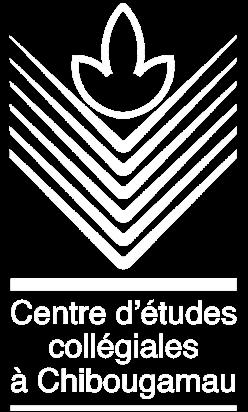


1st
2nd
3rd






Connect with Canada’s leading voices in Indigenous education from anywhere, like on your couch or in your classroom!
The National Gathering offers an amazing online experience where educators and partners unite to improve Indigenous K-12 outcomes. Be part of the conversation virtually or come to Winnipeg, MB this November 20-22!
Both online and in-person options available - learn more and register NOW at indspire.ca/national-gathering


CNG meetings with tallymen fail to calm the frustrations in the forest
by Patrick Quinn, Local Journalism Initiative Reporter
With mounting frustration over the impacts of mining and exploration activities in Eeyou Istchee, the Cree Nation Government and Cree Trappers’ Association held an information session for inland communities in Mistissini September 16.
Following presentations highlighting the role of tallymen, critical aspects of the James Bay and Northern Quebec Agreement and the CNG’s environmental and mining policies, an open dialogue involved nearly 300 participants. Many felt the three-minute time limit was insufficient to address concerns, however.
“I heard over 44 key messages that will be worked on,” said Grand Chief Mandy Gull-Masty. “Facing such a large spectrum, we need to find a mechanism suitable to everyone’s needs. It’s important you hear directly from people – it’s not something that’s done in one session.”
While some tallymen are staunchly anti-development, others want the potential for training, employment or economic opportunities for projects impacting their lands. Gull-Masty noted that the tallyman’s role has completely changed since it was defined in the JBNQA in 1975, saying it should be better aligned with modern realities and community expectations.
“People say we want better representation,” Gull-Masty conveyed. “I agree we can analyze that but at the same time we have to work within the JBNQA. It’s very clear you’re a tallyman because you’re recognized through that


structure. Once an individual decides to advocate for themselves independently, they don’t have the JBNQA to protect them.”
The consultation session follows unprecedented meetings this summer in Gatineau and Val-d’Or when tallymen gathered outside the territory to avoid any political influence. At the second meeting, 30 trappers unanimously approved a resolution demanding the CNG enact a law guaranteeing them a veto over their respective territories.
They also want to establish a new political entity asserting their rights regarding economic development on their traplines. While the CTA is mandated under the JBNQA to advocate for tallymen, many say it lacks its former resources and influence. Gull-Masty explained the CTA has gone through many internal changes and hasn’t always been responsive to requests, but suggested people could also contact local leadership or the Cree Mineral Exploration Board.
“CTA’s primary work seems to be delivering programs, and they aren’t really involved in any of these development activities,” said Sam Etapp, the tallymen group’s chairperson. “There’s no voice for these people. That’s why the tallymen have to stand up for themselves to be heard.”
entrepreneur Josiah Cooper organized the meetings with the financial support of his father, tallyman Gary Cooper, and the help of Tony Petawabano. Lawyer Peter Coon said tallymen want their rights legally recognized because their complaints aren’t addressed and agreements concerning them are signed without their consent.
“There’s a break somewhere in the communication that needs to be improved,” said Etapp. “Tallymen have responsibilities for the continuance of the traplines for many uses, including economic benefits. You can’t just sit back and watch development take place and not be involved in it.”
Etapp alleged that mining companies are being directed by some community leaders to not communicate with impacted families, who are instead given “observer status” with no authority on their traditional territories. Other sources have confirmed this practice, further alleging that companies aren’t being held accountable for incidents like Osisko’s fuel spill in 2023.
“Workers were not allowed to take pics, and they would be fired if they do,” shared Willie Icebound, who did it anyway. “They don’t care for the land my family hunt, fish and trap on. They go and attack that specific area we
mentioned to them. It’s like they’re provoking us and showing they can do whatever they want.”
When companies provide compensation for land degradation, impacted families sometimes don’t receive any benefits. While traplines used to feed families, Etapp is hearing people are barely getting by with the income security program and often can’t afford to go in the bush. Some tallymen enter partnerships or contracts to supplement their income.
“Some of these tallymen want to be contractors and get rich,” asserted Waswanipi tallyman Paul Dixon. “All my family members were offered machinery from Barrette-Chapais – my two sons were offered trucks. A lot of these guys took skidoos. I never took a red cent.”
With his trapline almost all logged out except for the islands, Dixon argued that the JBNQA was signed to protect Cree rights as a hunting society, not to be compensated for the destruction of its ancestral lands. He suggested efforts should focus on habitat restoration and protecting large sections of traplines that matter most to Cree families.
“The tallyman’s complaints have never been laid to rest, especially with the clearcutting and destroying the wildlife habitat,” said Dixon. “In Waswanipi, we say if you destroy the land, you destroy the animals, and in the end, you destroy the Cree people.”
Dixon was disappointed with the CNG’s information session, saying that in the independent meetings tallymen at least had the time to speak their minds. In Gatineau, one person commented, “I finally don’t feel alone anymore.”
While tallymen voiced concerns about mysterious helicopters hovering over their traplines, the Grand Chief explained that companies often buy exploration claims without realizing the need to communicate with communities and impacted land users. Since May, new regulations oblige exploration companies to apply for authorization for work requiring explosives or hydraulic machinery, such as excavation, drilling or road building.
“I do believe this new amendment will create clearer communication, but we need a more comprehensive structure so we’re aware of the different points of entry,” said Gull-Masty. “Sometimes the company will communicate with the band office or somebody in the field. There’s no standardized structure so there were many different entry points creating miscommunication.”
As the mining industry is public, Gull-Masty said it’s easy to go online to see who owns a claim on a trapline. Her office is working on a social acceptability report card that will enable impacted families to provide feedback on the consultation process and help those who don’t want mining activities on their trapline.
“All voices are valid in this,” Gull-Masty told the Nation “It’s those three levels that are required for social acceptability to happen – the tallyman, the community and the regional government. We do have the ability to say no if we do not want to see a project move forward.”





by Sonny Orr
s the skies below me cloud up and we cruise at a leisurely speed nearly six kilometres above the ground, I think back to the days when conversations couldn’t be heard over the loud drone of the piston engines on the old DeHavilland single engine Otter.
Times have changed greatly as today on the Dash 8 modern aircraft we cruise three times faster and with five times as many passengers. Back in the day air travel was literally flying by the seat of your pants and losing sight of the ground was a good way of losing your way to your destination.
I recall the times while working at the airport waiting for the rugged DC-3 to come in with the weekly groceries from Timmins. The arrival of the plane was the
only real entertainment we had. Some days, as the plane flew by to land, we would run to the landing strip just to be nosey and sometimes offer to help offload the plane for free! The only other real fun was to watch the weekly movie reels that had arrived on the plane. Sometimes, it was the next adventure of Buck Rogers or Tarzan.
Most films were black and white, but the latest long movies were in colour, which pleased us to no end. Zorro would put up a good sabre fight while Gene Autry was our favourite cowboy. Our most cherished actor was of course Jerry Lewis, who came up with quite a few zany flicks. When the movie ended, our laughter continued as we copied his crazy antics.

There were times when romance was highlighted with Elizabeth Taylor and one of her many suitors. The young girls turned their heads or peeked through their fingers as they covered their eyes. We boys would either say “yuck” or watch with wonder to see if anything else would happen.
It turned out that a lot of faces would get slapped if the kiss was unwanted so that made us wary of making the same foolish moves as the leading man. We learned how to avoid such disasters at an early age, noting instead that chivalry was the way to win a girl’s heart. As far as asking for her hand, well that was for grownups and who wanted to get married at 10 years old anyways?
At any rate, we preferred action movies and comedies. As I grew to become a strapping teenager going to school in the south, the movie theatres were my new passion. Once, I had a yearning to ask a pretty girl out on a date to see a movie –popcorn on me, of course.
“You decide which movie you want to see,” I proudly declared, and I heard her say the word star. I happily stammered back, “Yes! I’ll take you.” I couldn’t believe she wanted to see Star Wars.
Finally, as Tuesday rolled around, I got on the bus for the half-hour ride to Ottawa and met her outside the cinema. After it was over and we went outside, I noticed that she wasn’t happy. I asked her what was wrong, and she cried out that it was the worst film she’d ever seen.
I stuttered that I thought she wanted to see that one. “No!” she exploded. “I wanted to see A Star Is Born!”
Oops. It wasn’t action she wanted; it was romance. I was so shocked I couldn’t say much as I knew that I wouldn’t get another date. To this day, I’ve never seen that movie as I’m sure that I wouldn’t enjoy it.
Today, I watch only the short action parts of movies on social media and when I can I try to watch the whole downloaded movie. Not a single romantic movie has appeared on my device screen.
by Xavier Kataquapit
It seems these days that anyone protesting the war in Ukraine or Gaza is challenged with pushback from governments, various security forces and those in power that for some insane reason feel that conflicts, which are killing many thousands of people. are something we should all accept. Politicians, academics and media people are discouraged from questioning these wars. When they do the result can be troubling as they are discredited, branded as unpatriotic and, in some cases, fired from their jobs.
It is hard to believe that we are living in 2024 and that our governments are supporting and participating in war. People, children, women and the elderly are being killed. Cities are being destroyed along with infrastructure that will take years to rebuild.
The Middle East seems to be our western governments’ favourite hunting grounds as the mostly Islamic cultures from this area have been demonized and considered less than human, even barbaric. This happened during the Vietnam War. This kind of propaganda makes it easier to promote, finance and wage wars in that region. Why do we put up with it?
Right now, the Israeli military offensive in Gaza and Lebanon is out of control. Recently, the Lebanese have had to deal with a first in terroristic measures with mini bombs being activated in pagers and walkie talkies. Former CIA Director and US Defense Secretary Leon Panetta has publicly stated this kind of action is a form of terrorism. His remark makes you think about the safety of any device in public, when he stated, “This has gone right into the supply chain. And when you have terror going into the supply chain, it makes people ask the question: What the hell is next?” Imagine your cellphone turning into a mini bomb and exploding in your hands or pocket. That is terrifying.
The war in Ukraine is also out of control. Evidence points to the fact that the Russians, although guilty of invading the country, are being fought in a proxy war


by the US and even peaceful Canada. War does not need to happen ever, but there are warmongers and those who want to simply get rid of other cultures and competition. There’s a lot of money made on war and there are plenty of private companies that are profiting from the conflicts in the Middle East and Ukraine. Why are we not standing up to this?
There’s also the fear that either one of these conflicts could escalate into a nuclear exchange and that would threaten the entire world. We would no longer be watching distant populations die on TV or social media in the safety of our cozy homes. A nuclear war would come right to our doorstep and threaten our families and entire way of life. The best academic minds and many security and military people are warning us about how serious this situation is and reminding us that there will be no winner in a nuclear war.
I am no expert on war, but I’ve been researching the First and Second World Wars because my family and my partner’s family were severely affected over gener-
ations in losing relatives in both conflicts. The facts that we have unearthed on the rationale for these wars has terrorized us. Why we choose to spend money on war? Most leaders would rather spend billions on dealing with global problems with a military solution. What would happen if we instead chose to spend billions on peaceful solutions? If we pay for war, we will get war, but so far no one seems to want to spend much money on peace. However we choose to spend our money, we will get what we pay for.
These wars must end through negotiation so that we can choose different paths. We need to make our voices heard and cut through the propaganda that tries to convince people that war makes sense. If we don’t do this, we will pay with our own pain and suffering as these wars could end up tearing apart our society and the lives of everyone we know. We won’t be sitting back watching the horrors of war from a distance, we will be dealing with it in our own backyard. It is time to raise our voices against war.












REGIONAL GENERAL ASSEMBLY IN COLLABORATION WITH SCHOOL COMMITTEE ASSEMBLY
NOVEMBER 5-7, 2024 CHISASIBI, QUÉBEC
Join us for the Cree School Board’s 5th Regional General Assembly through Livestream or Radio Broadcast. This event will bring together School Committees and delegates to foster connections and collaboration.
GUIDED BY OUR CORE VALUES:
COURAGE HONESTY HUMILITY COMPASSION RESPECT
SHARING WISDOM TEAM WORK TEACHINGS
ACCESS: LIVESTREAM & BROADCAST
Morning sessions will be available via livestream and local radio.
Stay tuned for the event schedule and event link.
We look forward to welcoming you!




